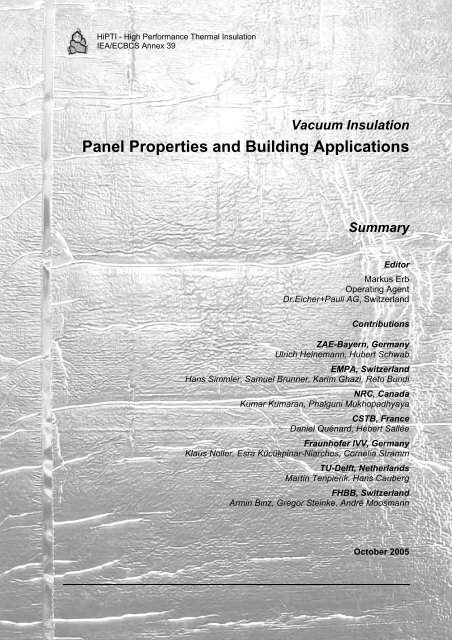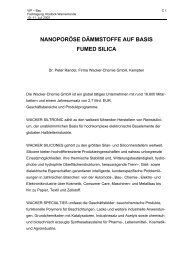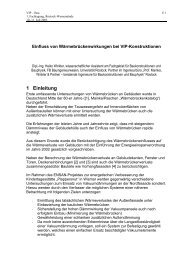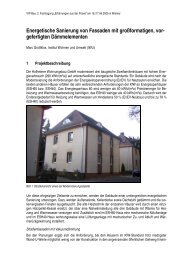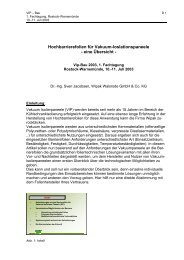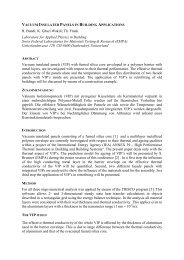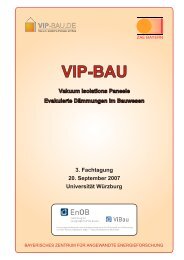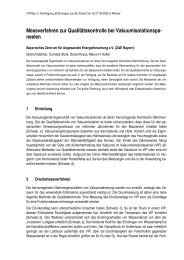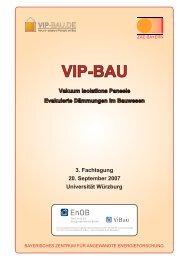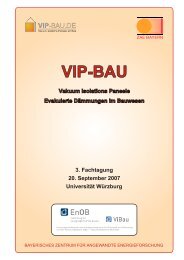2 IEA/ECBCS Annex 39 - VIP-Bau
2 IEA/ECBCS Annex 39 - VIP-Bau
2 IEA/ECBCS Annex 39 - VIP-Bau
Create successful ePaper yourself
Turn your PDF publications into a flip-book with our unique Google optimized e-Paper software.
HiPTI - High Performance Thermal Insulation<strong>IEA</strong>/<strong>ECBCS</strong> <strong>Annex</strong> <strong>39</strong>Vacuum InsulationPanel Properties and Building ApplicationsSummaryEditorMarkus ErbOperating AgentDr.Eicher+Pauli AG, SwitzerlandContributionsZAE-Bayern, GermanyUlrich Heinemann, Hubert SchwabEMPA, SwitzerlandHans Simmler, Samuel Brunner, Karim Ghazi, Reto BundiNRC, CanadaKumar Kumaran, Phalguni MukhopadhyayaCSTB, FranceDaniel Quénard, Hébert SalléeFraunhofer IVV, GermanyKlaus Noller, Esra Kücükpinar-Niarchos, Cornelia StrammTU-Delft, NetherlandsMartin Tenpierik, Hans CaubergFHBB, SwitzerlandArmin Binz, Gregor Steinke, André MoosmannOctober 2005
High Performance Thermal Insulation<strong>IEA</strong>/<strong>ECBCS</strong> <strong>Annex</strong> <strong>39</strong>SummaryImpressum<strong>IEA</strong>/<strong>ECBCS</strong> <strong>Annex</strong> <strong>39</strong>The work presented here is a contribution to <strong>Annex</strong> <strong>39</strong> of <strong>IEA</strong>/<strong>ECBCS</strong>-Implementing Agreement.TitleVacuum Insulation - Panel Properties and Building ApplicationsEditorMarkus ErbOperating AgentDr.Eicher+Pauli AG, SwitzerlandOctober 2005
High Performance Thermal Insulation<strong>IEA</strong>/<strong>ECBCS</strong> <strong>Annex</strong> <strong>39</strong>SummaryAbstractVacuum insulation panels (<strong>VIP</strong>) were already developed some time ago for use in appliancessuch as refrigerators and deep-freezers. Their insulation performance is a factor of five to tentimes better than that of conventional insulation. Used in buildings they enable thin, highlyinsulating constructions to be realized for walls, roofs and floors.The motivation for examining the applicability of high performance thermal insulation inbuildings (i.e. evacuated insulation in the form of vacuum insulation panels) came from thedifficulties involved in renovation – namely severe space limitations and therefore technicalconstraints, as well as from aesthetic considerations.Vacuum Insulation PanelsThe thermal resistance of evacuated insulation is a factor of five to ten better than conventionalinsulation of the same thickness. Vacuum insulation panels (<strong>VIP</strong>) in general are flatelements consisting of an open porous (and therefore evacuation-capable) core materialwhich has to withstand the external load caused by atmospheric pressure, as well as asufficiently gas-tight envelope to maintain the required quality of the vacuum.Nano-structured materials have been found to require the least quality of vacuum, which hasto be achieved and to be maintained. In panels basically made of pressed fumed silica, thecontribution of the gas to the total heat transfer is virtually eliminated even at an internal gaspressure of a few hundred Pascals. The requirements on the gas-tightness of the envelopeare also relatively moderate for these extremely fine-structured core materials – the largestpores are in the order of 100 nanometres. Thin laminated metal foils and special high-barriermetallized laminates consisting mainly of polymers are therefore used for the envelope. Thisreport focuses especially on this type of <strong>VIP</strong>, which combines relatively simple and flexibleproduction methods (and is therefore currently the least expensive alternative) with an servicelife of 30 to 50 years, limited by air permeation into the panels. Even if the vacuum failedcompletely, the thermal resistivity of this filler material is twice as efficient as that of anystandard insulation material.Investigations have been performed individually on the core materials and laminates designedfor the envelope as well as manufactured <strong>VIP</strong>.Building ApplicationsThe introduction of such a novel insulation system in the building trade, however, is hamperedby many open questions and risks. The work illustrates a wide selection of reportsfrom practice, shows how the building trade deals with this new insulation system today, theexperience gained and the conclusions drawn there from. As well as presenting recommendationsfor the practical use of <strong>VIP</strong>, the report is also able to answer questions regarding theeffective insulation values to be expected with today's <strong>VIP</strong>.Page I
High Performance Thermal Insulation<strong>IEA</strong>/<strong>ECBCS</strong> <strong>Annex</strong> <strong>39</strong>SummaryContentABSTRACTCONTENTIII1 INTRODUCTION 12 <strong>IEA</strong>/<strong>ECBCS</strong> ANNEX <strong>39</strong> 23 VACUUM INSULATION PANELS 43.1 Core 43.2 Envelope 73.3 Aging 94 BUILDING APPLICATIONS 144.1 Thermal bridging 144.2 <strong>VIP</strong> in practical use 184.3 Use of <strong>VIP</strong> – Recommendations 225 OUTLOOK 24REFERENCES 26Page II
High Performance Thermal Insulation<strong>IEA</strong>/<strong>ECBCS</strong> <strong>Annex</strong> <strong>39</strong>Summary1 IntroductionThe motivation for examining the applicability of high performance thermal insulation inbuildings (i.e. evacuated insulation in the form of vacuum insulation panels) came from thedifficulties involved in renovation – namely severe space limitations and therefore technicalconstraints, as well as from aesthetic considerations.The following numbers give an impression on potential impact vacuum insulation could haveon energy consumption:In 1997, about 25% of the energy consumption in the EU came from room heating.In 1995, there were roughly 150 million dwellings in the EU-15, 32% of this stock was builtprior to 1945, 40% between 1945 and 1975 and 28% between 1975 and 1995.Table 1: Energy consumption of buildings in Europe. (Source:Directive of the European Parliament And The Council on theenergy performance of buildings.)Residential Sector [%] Commercial [%]Space Heating 57 Space Heating 52Water Heating 25 Water Heating 9Electric Appliances 11 Lighting 14Cooking 7 Office Equipment 16Cooking 5Cooling 4Page 1
High Performance Thermal Insulation<strong>IEA</strong>/<strong>ECBCS</strong> <strong>Annex</strong> <strong>39</strong>Summary2 <strong>IEA</strong>/<strong>ECBCS</strong> <strong>Annex</strong> <strong>39</strong>Germany and Switzerland were the first two countries supporting R&D activities with the aimof introducing <strong>VIP</strong>-technology to the building industry. In 2000 Switzerland decided to launchthe topic on an international level. This happened in the frame of the <strong>IEA</strong> (InternationalEnergy Agency) Implementing Agreement called <strong>ECBCS</strong> (Energy Conservation in Buildingsand Community Systems). Implementing Agreements are a kind of international networks ofnational representatives with the aim of coordinating applied research in the field of energy.<strong>Annex</strong> <strong>39</strong> is the <strong>39</strong>th research program of <strong>ECBCS</strong>. It was officially adopted by the ExecutiveCommittee of <strong>ECBCS</strong> in November 2000 and started with an international conference inJanuary 2001.Since the topic was new to the research community, it was quite difficult to set up a workplan with the participating institutes. One problem for instance was the lack of standardmethods to study <strong>VIP</strong>. But finally a work plan with two main fields of activity was developed:Subtask A: PanelsExisting products, mainly <strong>VIP</strong>, will be analysed and their properties optimised in the way, thatthey meet the requirements of the systems in which they will be applied.Measurement standards concerning product declaration and quality monitoring procedureswill be developed.Subtask B: ApplicationsPart 1: Application and system developmentSupport companies which want to develop <strong>VIP</strong>-systems for the building envelope and HVACcomponents. The support will consist in informing potential companies about <strong>VIP</strong>, formsuitable groups for each development project, provide theoretical and practical information(simulation and testing of systems).Part 2: Demonstration and information disseminationRealize demonstration projects together with well-known architects and important buildingowners.Lessons learned from the demonstration projects will be collected and used for further improvementof the materials and systems.Information material will be distributed to increase the interest of construction companies andclients.Page 2
High Performance Thermal Insulation<strong>IEA</strong>/<strong>ECBCS</strong> <strong>Annex</strong> <strong>39</strong>SummaryParticipating institutes<strong>Annex</strong> <strong>39</strong> Name e-mail ContributionDr.Eicher+PauliAGSwitzerlandSubtask AMarkus Erb markus.erb@eicher-pauli.ch Operating AgentIntroductionZAE-BayernGermanyUlrich HeinemannHubert Schwabheinemann.ulrich@zae.uniwuerzburg.deschwab@zae.uni-wuerzburg.deLeader Subtask ACore material,Panel, Qualityassurance , OutlookEMPASwitzerlandHans SimmlerSamuel Brunnerhans.simmler@empa.chsamuel.brunner@empa.chPanelNRC/IRCCanadaKumar KumaranPhalguni Mukhopadhyayakumar.kumaran@nrc.caphalguni.mukhopadhyaya@nrccnrc.gc.caCore material,EnvelopeCSTB*FranceDaniel QuénardHébert Salléequenard@cstb.frsallee@cstb.frCore materialFraunhofer IVVGermanyKlaus NollerEsra Kücükpinar-Niarchosklaus.noller@ivv.fraunhofer.deesra.kucukpinar@ivv.fraunhofer.deEnvelopeCornelia Strammcornelia.stramm@ivv.fraunhofer.deTU DelftNetherlandsMartin TenpierikHans Caubergm.j.tenpierik@bk.tudelft.nlh.cauberg@chri.nlPanelSubtask B Name e-mail ContributionFHBBSwitzerlandArmin BinzAndré MoosmannGregor Steinkea.binz@fhbb.chandre.moosmann@fhbb.chgregor.steinke@fhbb.chLeader Subtask BReport editor,Practice Report I,Recommendations,EconomicsEMPASwitzerlandKarim GhaziReto Bundikarim.ghazi@empa.chreto.bundi@empa.chThermal bridgesZAE-BayernGermanyUlrich HeinemannHubert Schwabheinemann.ulrich@zae.uniwuerzburg.deschwab@zae.uni-wuerzburg.dePractice Report IITU DelftNetherlandsHans CaubergMartin Tenpierikh.cauberg@chri.nlm.j.tenpierik@bk.tudelft.nlCase studiesKTH StockholmSwedenGudni JohannessonThomas Thorsellgudni@bim.kth.sethomas.thorsell@byv.kth.seEdge effect(stainless steel)Page 3
High Performance Thermal Insulation<strong>IEA</strong>/<strong>ECBCS</strong> <strong>Annex</strong> <strong>39</strong>Summary3 Vacuum Insulation PanelsVacuum insulation panels (<strong>VIP</strong>) in general are flat elements consisting of an open porous(and therefore evacuation-capable) core material which has to withstand the external loadcaused by atmospheric pressure, as well as a sufficiently gas-tight envelope to maintain therequired quality of the vacuum.multi-layer envelopefilmcore-bagpressed silica corewith opacifierwelded seamFigure 1: Components of a <strong>VIP</strong>. The core-bag providesmechanical stability for handling and protects the weldingarea from being polluted by core-powder.(foto: va-Q-tec).3.1 CoreNano-structured materials have been found to require the least quality of vacuum, which hasto be achieved and to be maintained. In panels basically made of pressed fumed silica, thecontribution of the gas to the total heat transfer is virtually eliminated even at an internal gaspressure of a few hundred Pascal.Page 4
High Performance Thermal Insulation<strong>IEA</strong>/<strong>ECBCS</strong> <strong>Annex</strong> <strong>39</strong>SummaryFigure 2: SEM image - Pore Size Distribution.(Source: Wacker / ZAE-Bayern)Thermal conductivity 10 -3 W/m.K28 Fumed Silica 1 CSTBFumed Silica 2 CSTBSilica CSTB24 Fumed Silica ZAEPU Foam201612841E-3 0.01 0.1 1 10 100 1000Pressure hPaFigure 3: Thermal Conductivity versus pressure of a PU,three fumed silica and one precipitated silica sample.The densities are in the range of 160 kg/m³ to 190 kg/m³. The porosity is higher than 90%,the specific surface area is higher than 200 m²/g. High sorption capability results from thehuge specific surface area. Thus fumed silica may act as a desiccant.For high humidity, from 60 up to 95%, there is an exponential increase mainly due to thecapillary condensation in the small pores. Indeed, according to the Kelvin-Laplace law, at95%, all the pores with a size smaller than 20 nm are filled with water.Page 5
High Performance Thermal Insulation<strong>IEA</strong>/<strong>ECBCS</strong> <strong>Annex</strong> <strong>39</strong>Summary∂λ∂p ≈ 0.035mWmK mbarin the range up to 100 mbar(2)λ: thermal conductivity, W/(m·K)p: “dry gas” pressure in the pores, mbarThus a dry gas pressure increment of 30 mbar corresponds to a thermal conductivity increaseof about 1⋅10 −3 W/(m⋅K).3.2 EnvelopeThe most critical component of a Vacuum Insulation Panel (<strong>VIP</strong>) is the envelope, which isresponsible for the maintenance of the vacuum inside the panel. Normally polymer laminatesare used which contain metallized polymers or aluminium foils as barrier layer.Figure 6: Permeation mechanism (schematic) through alaminate containing two homogenous polymers.As with all polymeric films, the transmission rate for water vapour (WVTR) for these laminateswas found to be several orders of magnitude greater than those for oxygen (OTR) ornitrogen: The units used for WVTR is g/(m²·d) and for OTR cm³(STP)/(m²·d) and today productsdo have WVTR and OTR in the same range but 1 g H 2 O equals 1’244 cm 3 .Page 7
High Performance Thermal Insulation<strong>IEA</strong>/<strong>ECBCS</strong> <strong>Annex</strong> <strong>39</strong>SummaryTable 1: Laminate transmission rates according to manufacturer’s specifications for the tested laminates.PET=PolyEthylenTerephtalate, PE=PolyEthylen, PP=PolyPropylen, LD=LowDensity, met=Al-layer 30 to 80nm thick.Name Laminate composition OTR[cm³(STP)/(m²·d)]AF 12 µm PET / 8 µm Al / 100 µm PE-LD < 0.0005(25°C / 50% RH)MF1 15 µm PPmet / 12 µm PETmet / 50 µm PE 0.07(23°C / 50% RH)MF2 20 µm PETmet / 20 µm PETmet / 25 µm PE 0.00062(23°C / 75% RH)WVTR[g/(m²·d)]< 0.005(20°C / 50% RH)0.1(38°C / 90% RH)0.005(23°C / 75% RH)1.0000.100Water vapor and oxygen transmission rates(producer declaration)OTR [cm³(STP)/(m²·d)]WVTR [g/(m²·d)]0.0100.0010.000AF1 < MF1 MF212 µm PET / 8 µmAl / 100 µm PE-LD15 µm PPmet / 12µm PETmet / 50µm PE20 µm PETmet / 20µm PETmet / 25µm PEFigure 7: Transmission rates (producer declaration) of analuminium foil based film (AF) and two polymer basedmetallized films (MF).Measuring extremely low permeation rates is challenging and very time-consuming. A fastmeasurement tool was developed to derive water vapour transmission rates from heliumtransmission measurements. The effects of corners and edges on water vapour and onoxygen transmission rates were also determined.Page 8
High Performance Thermal Insulation<strong>IEA</strong>/<strong>ECBCS</strong> <strong>Annex</strong> <strong>39</strong>Summary3.3 AgingThe thermal conductivity λ cop of a well evacuated dry <strong>VIP</strong> with a fumed silica core is typicallyabout 0.004 W/(m·K) after production. As the low internal pressure is not in equilibrium withthe environment, pressure gradients are present that act as driving forces for the intrusion ofatmospheric gas (essentially N 2 , O 2 and H 2 O) and by this the thermal performance of <strong>VIP</strong> isimpaired in two ways:- increasing internal gas pressure and- increase in the internal water content.3.3.1 Aging vs. durabilityIn this context one might distinguish between aging and durability in the following sense:aging is a continuous process of performance degradation due to (normally) slow permeationof atmospheric gas molecules through the imperfect barrier, resulting in a non-reversiblepressure increase and moisture accumulation in the hygroscopic <strong>VIP</strong> core. In contrast,durability is the ability of a <strong>VIP</strong> to withstand chemical or mechanical impacts that would causefailure of the barrier envelope, thus changing the internal low-pressure state within a shorttime by severe damage or rupture of the barrier. Regarding durability the risks for <strong>VIP</strong> insuitable building applications occur mainly before or during installation. A certain failure rateis present at the production plant, caused by material imperfections or processing errors.This type of failure can be largely avoided by quality control as well as by storing the panelsduring a specified time under defined conditions and checking them before they are shipped.It can be stated that the number of damaged or defective panels leaving the production plantwas substantially reduced in the last few years. The figure is roughly assumed to be lessthan one percent. More frequent failures occur during transportation and handling of thepanels until they are safely installed. Without protection the envelope is highly sensitive tomechanical impact, especially to point loads e.g. by sand grains, bricks or stone fragments,or other sharp objects including tools and corners of other panels. Once installed workmanlike,failure risks are observed to be low.3.3.2 Measurement methodsMeasurements on panels stored in different climatic conditions gave detailed information onpermeation rates for air and water vapour as a function of temperature and humidity includingall the effects of edges, corners and processing.As a very accurate method to measure the internal pressure of panels a depressurizationbased method has been successfully applied by ZAE-Bayern, EMPA and NRC: the pressurearound a <strong>VIP</strong> specimen is continuously reduced in a vacuum chamber. If the pressure in thechamber diminishes to below the <strong>VIP</strong> pressure, the <strong>VIP</strong> envelope lifts off the core surface.This can be recorded visually or by using photo electric sensors.Page 9
High Performance Thermal Insulation<strong>IEA</strong>/<strong>ECBCS</strong> <strong>Annex</strong> <strong>39</strong>Summary3.3.3 Results3.3.3.1 OverviewThe laminate with only one metallized layer was clearly proved not to fulfil the requirements.Acceptable pressure increases of about 1 mbar per year can be expected for <strong>VIP</strong> with an Alfoiland for laminates with three metallized layers.Table 2: Area (subscript A) and perimeter (subscript L) related transmission characteristics of <strong>VIP</strong> withmetallized polymer laminates (MF) for 23°C, 50% RH and 1 bar. For the MF1 and MF2 samples, anWVTR L value (edge effect) could not be determined since the panels were too small.Barrier type WVTR A , g/(m 2 d) WVTR L , g/(m d) ATR A , cm 3 /(m 2 d) ATR L , cm 3 /(m d)MF1 0.0233 - 0.0160 0.0080MF2 0.0057 - - 0.00<strong>39</strong>MF3 0.0030 0.0008 0.0034 0.0091MF4 0.0048 0.0006 0.0088 0.00183.3.3.2 Air-transmission - edge-effectThe significant contribution of air permeation through the edge-area of the <strong>VIP</strong> postulatesthat panels may not be too small in size, (i.e. larger than 50 cm x 50 cm).Pressure increasedp [mbar/yr]4321Air permeationMF 1MF 2MF 3MF 400.0 0.2 0.4 0.6 0.8 1.0panel area [m 2 ]Figure 8: Edge effect on internal pressure increase by air permeation through fourdifferent metallized films (rectangular panel).3.3.3.3 Water vapour transmissionWater vapour uptake in the threefold metallized film was found to be mainly dependent onthe size of the panel surface - much smaller edge effect than for air permeation, whereas thepanels with Al-film absorbed water vapour at a much lower rate, and this occurred mostlythrough the edges and seams.Page 10
High Performance Thermal Insulation<strong>IEA</strong>/<strong>ECBCS</strong> <strong>Annex</strong> <strong>39</strong>SummaryWeight increaseWater vapour permeationXw [%-mass/yr]0.60.50.40.30.20.1MF1MF2MF3MF40.00.0 0.2 0.4 0.6 0.8 1.0panel area [m 2 ]Figure 9: Edge effect on weight increase by water vapour permeation through fourdifferent metallized films. For the MF1 and MF2 samples, an edge effect could notbe determined since the panels were too small (rectangular panel).3.3.3.4 Climatic dependencies of transmission ratesThe dependence of air transmission rates on temperature can be described by the Arrheniuslaw with activation energies that are in the range of 25 to 40 kJ/mol.Water vapour transmission rates are proportional to the differences in the partial pressuresinside and outside, a significant explicit dependence on temperature could not be observed.dp [mbar/yr]Pressure increase vs. temperaturePanel format 20 x 20 x 1 cm 3 (H 2 O 14 mbar)40AF35MF130MF2252015105020 30 40 50 60 70Temperature [°C]dm [M-%/a]25%Weight increase vs. H 2 O partial pressurePanel format 25 x 25 x 2 cm 320%80°C15%10%5%65°C23°C 30°C0%0 50 100 150 200 250 300 350 400H 2 O partial pressure [mbar]Figure 10: Internal pressure increase caused by dry air (left) and water vapour (right) permeation. The measurementswere done at room temperature after cooling down the samples for some hours.Page 11
High Performance Thermal Insulation<strong>IEA</strong>/<strong>ECBCS</strong> <strong>Annex</strong> <strong>39</strong>Summary3.3.3.5 <strong>VIP</strong> service life predictionWith the following equation the increase in the thermal conductivity of the <strong>VIP</strong> as a functionof time can be calculated:λfree,airλ () t = λevac++ b ⋅ Xw() t .p1 / 2,air1 +pair() t(3)The following values apply to <strong>VIP</strong> with fumed silica kernels of density ρ <strong>VIP</strong> ≈ 170 kg/m³,λ evac = 4·10 −3 W/(m·K), p 1/2,air ≈ p 1/2,N2 = 600 mbar, λ air = 25·10 −3 W/(m·K) at 10°C and b =0.5·10 −3 W/(m·K)/%-mass at a mean temperature of 10°C. From the sorption isotherm k =0.08%-mass per percent of relative humidity follows.With the transmission characteristics of a certain laminate, p air (t) and X W (t) can be obtainedand λ(t) calculated, as shown for MF2 in the figure below.total thermalconductivity [10 -3 W/(mK)]7.06.05.04.03.02.01.0film MF2total for (50 x 50 x 1) cm³total for (100 x 100 x 2) cm³increase by humidity for (50 x 50 x 1) cm³increase by humidity for (100 x 100 x 2) cm³increase by air for (50 x 50 x 1) cm³increase by air for 100 x 100 x 2 cm³7.06.05.04.03.02.01.0increase in thermalconductivity [10 -3 W/(mK)]0.00 5 10 Zeit [y] 15 20 250.0Figure 11: Total thermal conductivity as a function of time (upper part, left ordinate) and increases in airrelatedand humidity-related thermal conductivity (lower part, right ordinate) of <strong>VIP</strong> with film MF2 for differentpanel sizes.3.3.4 ConclusionsIf a time span of 25 years and typical environmental conditions (23 to 25°C and ambientvapour pressure) are taken as a basis for the long-term performance it can be concluded thatthe pressure increase will be rather linear over the whole period, whereas the moisturePage 12
High Performance Thermal Insulation<strong>IEA</strong>/<strong>ECBCS</strong> <strong>Annex</strong> <strong>39</strong>Summarycontent could approach the saturation range (about 4%-mass) within this time period. Moistureequilibrium under normal conditions is basically acceptable, but must be accounted forby a respective increment on the initial thermal conductivity.Maximum values (approximate) for <strong>VIP</strong> with actual multi-layer metallized polymer laminatebarriers, measured or calculated from laboratory based aging experiments, are given in thetable below. Applying known relations for the pressure and moisture impact on the thermalconductivity, maximum values for the thermal conductivity after 25 years are given in thetable as well. These values are thought to be on the safe side in applications with <strong>VIP</strong> surfacetemperatures and vapour pressures in the range of ambient or indoor air.Table 3: Aging characteristics for SiO 2 -<strong>VIP</strong> with polymer based multiple metallized barrier (safe values).50 x 50 x 2 cm 3 100 x 100 x 2 cm 3Pressure increase [mbar/yr] < 2.0 < 1.0Moisture accumulation (initial) [%-mass/yr] < 0.2 < 0.2Thermal conductivity λ cop (25 yr) [W/(m·K)] < 0.008 < 0.0073.3.5 Design valuesFrom the results of the aging studies, design values of the thermal conductivity for the center-of-panel(λ cop ) can be derived.Table 4: Swiss design values (safe values) of Center-of-panel thermalconductivities (λ cop ) for aluminium and polymer based multiple metallizedbarrier envelopes.Swiss center-of-panel conductivity valuesλ copAF: aluminium foil films [W/(m·K)] 0.006MF: metallized polymer films [W/(m·K)] 0.008In Switzerland a safety increment of 0.004 W/(m·K) is put on the “ideal” initial thermal conductivityvalue of 0.004 W/(m·K) for <strong>VIP</strong> with metallized polymer barrier. One part is due tothe non-negligible moisture accumulation, which may be around 4%-mass in the long term,corresponding to a thermal conductivity increment of about 0.002 W/(m·K). In addition, a dryair pressure increase of 50 mbar is accounted for, roughly corresponding to another 0.002W/(m·K) increment. Half increments are taken for <strong>VIP</strong> with metal foil based barrier. Thesefigures are thought to be on the safe side with respect to both pressure increase and moistureaccumulation over a time span of 25 years. It should be noted that this is a preliminaryapproach. If clearly better barrier quality is proven and proper initial conditions (low pressure,low moisture content) are guaranteed by the manufacturer, lower (individual) design valuesmay be considered by the Swiss thermal insulation standardisation committee.Page 13
High Performance Thermal Insulation<strong>IEA</strong>/<strong>ECBCS</strong> <strong>Annex</strong> <strong>39</strong>Summary4 Building ApplicationsThe core part of the Subtask B report consists of practice reports, showing actual exampleswhere vacuum insulation panels (<strong>VIP</strong>) have been used, and discussing special issues andopen questions. A wide range of built examples, all using <strong>VIP</strong>, such as floor and ceilingconstructions, terrace insulation, non-loadbearing sandwich elements, parapet insulation,prefabricated façade elements etc. form a rich basis of experience for interested plannersand experts as well as manufacturers in search of new products with integrated <strong>VIP</strong>. Furthermore,the report states the actual knowledge on reliability, thermal bridge effect of thepanel envelopes, i.e. the resulting thermal resistance of <strong>VIP</strong>, and recommended constructionswith <strong>VIP</strong>.4.1 Thermal bridgingThree different basic levels of thermal bridging can be distinguished:- thermal bridging due to the thin film high barrier enveloping the core material- thermal bridging due to the small air gap between two adjacent panels- thermal bridging due to constructional irregularitiesFigure 12: Schematic representation of a coldbridge caused by the <strong>VIP</strong> envelope.Due to thermal bridging the effective or overall thermal conductivity, λ eff , of the vacuuminsulation panel is higher than the ideal centre-of-panel thermal conductivity λ cop . The amountof this thermal bridge effect is also affected by the thermal properties material layers immediatelysurrounding the <strong>VIP</strong>. The effective thermal conductivity of a <strong>VIP</strong> takes all nonhomogeneities,originating from the product itself as well as from the joint between adjacent<strong>VIP</strong> into account. With other words, the effective thermal conductivity of a <strong>VIP</strong> represents theconductivity of a homogeneous material with equivalent thermal behaviour. By means ofmeasurements carried out in a guarded hot plate apparatus on <strong>VIP</strong> samples of three differentthicknesses and two different sizes, the effective thermal conductivity, i.e. the linear thermaltransmittance Ψ <strong>VIP</strong> of the <strong>VIP</strong> themselves has been determined.Page 14
High Performance Thermal Insulation<strong>IEA</strong>/<strong>ECBCS</strong> <strong>Annex</strong> <strong>39</strong>SummaryThis effective thermal conductivity can be calculated asλ eff = λ cop +Ψ <strong>VIP</strong> · d · p / A (4)λ cop centre-of-panel thermal conductivity [W/(m·K)]d thickness of the <strong>VIP</strong> (in the heat flux direction) [m]A surface of the <strong>VIP</strong> (perpendicular to the heat flux direction) [m 2 ]p perimeter of the surface A [m]Ψ <strong>VIP</strong> linear thermal transmittance [W/(m·K)]4.1.1.1 Envelope materialsEffective thermal conductivities for different envelope materials have been measured andmodeled. Assuming a panel size of 1.00 x 0.50 x 0.02 m 3 results:- 8 µm aluminium foil: λ cop 6·10 -3 W/(m·K), Ψ 0.033 W/(m·K)→ λ eff 10.0·10 -3 W/(m·K)- 50 µm stainless steel foil: λ cop 6·10 -3 W/(m·K), Ψ 0.026 W/(m·K)→ λ eff 9.1·10 -3 W/(m·K)- three layer metallized film: λ cop 8·10 -3 W/(m·K), Ψ 0.006 W/(m·K)→ λ eff 8.7·10 -3 W/(m·K)λeff [mW/(mK)]3530252015105λ eff for <strong>VIP</strong> with different envelope materialsThree layer metallized film50 micron stainless steel8 micron aluminium00.0 0.5 1.0 1.5 2.0panel area [m 2 ]Figure 13: Thermal bridge effect of different envelope materials on overallconductivity (λ eff ) of a rectangular panel with center-of-panel conductivity (λ cop )of 8•10 -3 W/(m•K) for the metallized film and 6•10 -3 W/(m•K) for the aluminium foiland the stainless steel envelope.Page 15
High Performance Thermal Insulation<strong>IEA</strong>/<strong>ECBCS</strong> <strong>Annex</strong> <strong>39</strong>Summary4.1.1.2 Adjacent materialsAs well as the properties of the core material and the envelope, the Ψ <strong>VIP</strong> value is influencedby the material layers immediately surrounding the <strong>VIP</strong>. At the EMPA the influence of varioussurrounding materials has been investigated. The calculations were performed for a <strong>VIP</strong>(20 mm) with metallized enveloping laminate for the adjacent materials metal, glass, woodand insulation, in each case without an air gap between the <strong>VIP</strong> and with a 5 mm air gapbetween the panels. Here the design value of λ cop for metallized films of 8•10 -3 W/(m•K) wasused.Thermal bridging by adjacent materials0.0120.011d 50x100d 100x100center of panel ("aged" design value)0.010λ [W/mK]0.0090.0080.0070.0062 mm Steel(no gap)5 mm Glass(no gap)20 mm Wood(no gap)5 mmInsulation (nogap)2 mm Steel(gap)5 mm Glass(gap)20 mm Wood(gap)5 mmInsulation(gap)Figure 14: Thermal bridge edge effect of different adjacent materials on overall conductivity(λ eff ) of a panel with MF-envelope and a center-of-panel conductivity of 8•10 -3 W/(m•K).“d 100x100” is the increase for a panel of 100x100 cm 2 compared to λ cop and “d 50x100”is the increase for a panel of 50x100 cm 2 compared to the lager format.4.1.1.3 Façade panel constructionsWith edge spacer constructions both component facings are mechanically jointed by meansof a load transmitting edge spacer, while with the sandwich construction the componentfacings are adhered to a core material to form a structurally active sandwich.Page 16
High Performance Thermal Insulation<strong>IEA</strong>/<strong>ECBCS</strong> <strong>Annex</strong> <strong>39</strong>SummaryFigure 15: Different edge spacers. a.) aluminium spacer double-glazing; b.) sealant spacer; c.) reinforcednon-metallic tape (0.15 mm); d.) optimised thermoplastic spacer (Henkel Tereson Thermoplastic Spacer);e.) polymer U-section.For the calculations the following edge spacer materials were used:Fumed silica based <strong>VIP</strong> (λ cop = 0.008 W/(m·K))- Edge spacer a: standard double-glazing aluminium edge spacer (λ = 225 W/(m·K))polysulfide sealant (λ = 0.40 W/(m·K)) and silicon sealant (λ = 0.35 W/(m·K))- Edge spacer b: butyl sealant (λ = 0.24 W/(m·K))- Edge spacer c: non-metallic tape (λ ≈ 0.33 W/(m·K)); thickness ≈ 0.15 mm- Edge spacer d: thermoplastic spacer (λ = 0.25 W/(m·K))polysulfide (λ = 0.40 W/(m·K))0.035Thermal bridging by different spacer0.0300.025d Lambda.effLambda w/o spacerλeff [W/mK]0.0200.0150.0100.0050.000AF MF AF MF AF MF AF MFspacer a(aluminium)spacer b (sealant)spacer c (nonmetallictape)spacer d(thermoplastic)Figure 16: Thermal bridge edge effect of different spacers in façade panel constructions.The used<strong>VIP</strong> have metallized- (MF) or aluminium foil (AF) envelopes. Thecenter-of-panel conductivity is 8•10 -3 W/(m•K). The outside facing is 6 mm glass andthe inside facing is 1.5 mm aluminium. “d Lambda.eff” is the increase for a panel of100x100x2 cm 3 compared to λ cop .Page 17
High Performance Thermal Insulation<strong>IEA</strong>/<strong>ECBCS</strong> <strong>Annex</strong> <strong>39</strong>SummaryAs can be seen as well, aluminium spacers (spacer a) are not suitable for façade panels withincorporated vacuum insulated panels, because a linear thermal transmittance, Ψ, of approximately0.30 (MF) to 0.34 (AF) leads to an increase in effective U-value for a panel of1 x 1 m 2 with 20 mm vacuum insulation panel from approximately 0.31 (MF) and 0.<strong>39</strong> (AF) to1.23 and 1.33 W/(m 2·K). Better performances can be expected from the spacers b and d,while the best performance is calculated for the reinforced non-metallic tape (forλ cop = 0.008 W/(m·K) the U-value U eff = 0.65 W/(m 2·K) for a 20 mm vacuum insulation panelconstruction with an aluminium foil and U eff = 0.44 W/(m 2·K) for a 20 mm vacuum insulationpanel construction with a metallized polymer film. This reinforced tape, however, might notadequately transmit forces, especially if wind suction is the main load to be transmitted. Forsandwich panels, however, this edge spacer does not have to transmit loads and can thus beused for safety and protection against damage.4.2 <strong>VIP</strong> in practical use<strong>VIP</strong> are today mainly installed directly in the construction on site. By far the commonest useis the insulation of flat roof terraces with <strong>VIP</strong>. In the following table the 20 examples, whichhave been analysed and documented in [<strong>IEA</strong> 2005b] of <strong>VIP</strong> applications are shortly characterized.Project City /CountryBuilding Application PlaceNew.Renov.FaçadeCeilingRoofOtherexteriorinteriorFloor and ceilinginsulationAttachment to asingle-family houseZugSWIx x xInterior and dormerwindow insulationRefurbishment ofpropertyZürichSWIx x x x x xTerrace insulationMultifamily housesKerzersSWIx x x xPage 18
High Performance Thermal Insulation<strong>IEA</strong>/<strong>ECBCS</strong> <strong>Annex</strong> <strong>39</strong>SummaryProject City /CountryBuilding Application PlaceNew.Renov.FaçadeCeilingRoofOtherexteriorinteriorFloor insulation in acold and deepfreezeroomConversion of ashopSWIx x xNon-load bearingwall sandwichelementsSingle-family houseWinterthurLandschlachtSWIx x xParapet insulation inwindow elementApartment conversionin a multifamilyhouseBaselSWIx x xFaçade insulationwith prefabricatedpanelsTerraced housesSWIx x xFaçade insulationRenovation of asemi-detachedhouseBinningenNuernbergGERx x xPage 19
High Performance Thermal Insulation<strong>IEA</strong>/<strong>ECBCS</strong> <strong>Annex</strong> <strong>39</strong>SummaryProject City /CountryBuilding Application PlaceNew.Renov.FaçadeCeilingRoofOtherexteriorinteriorInsulation of outsidewalls, roof and doorA new semidetachedwoodenhouseMunichGERx x x x xInsulation of thebuilding envelopeComplete renewal ofa terraced houseMunichGERx x x x xInsulation of a wallheating systemRenovation of aformer churchWernfeldGERx x x xJamb-crossbarconstructionExtension of theHospitalGERx x xIntegrated façadeelement with radiatorTest façade ZAEBayernErlenbachWuerzburgGERx x x xInsulated prefabricatedconcreteelementsOffice building withan apartmentRavensburgGERx x xPage 20
High Performance Thermal Insulation<strong>IEA</strong>/<strong>ECBCS</strong> <strong>Annex</strong> <strong>39</strong>SummaryProject City /CountryBuilding Application PlaceNew.Renov.FaçadeCeilingRoofOtherexteriorinteriorFaçade insulationPassive houseBersenbrueckGERx x xFaçade insulationwith polystyrenelined<strong>VIP</strong>Terraced houseTrierGERx x xFaçade insulationRefurbishment of anapartment and officeblockMunichGERx x xFloor insulationAllgäu Energy andEnvironment CentreKemptenGERx x x xFloor insulationRenovation of thehistoric court houseGERx x xFloor insulationRenovation withinsulation underunderfloor heatingSchaffhausenGemuendenGERx x xPage 21
High Performance Thermal Insulation<strong>IEA</strong>/<strong>ECBCS</strong> <strong>Annex</strong> <strong>39</strong>Summary4.3 Use of <strong>VIP</strong> – RecommendationsAlthough the processing of <strong>VIP</strong> under controlled conditions by specially trained personnel ina factory would be highly desirable, only a few prefabricated products and systems areavailable for the building sector. However, ongoing activities point out that more and morecomponent and system manufacturers are becoming involved in the development of suchproducts. It can therefore be expected that in the near future, a wide range of products suchas floor heating systems, outside doors and façade elements with <strong>VIP</strong> will be available.<strong>VIP</strong> is more than a new material – it must rather be regarded as a system, one of considerablecomplexity and sensitivity. It is therefore important that all concerned are informed,advised as early as possible and are supported by a specialist during the entire planning andinstallation process (preferably by the <strong>VIP</strong> supplier). In whatever way <strong>VIP</strong> are used in theconstruction branch, those responsible should make sure that during the planning and buildingprocess, no one handles <strong>VIP</strong> without having sufficient knowledge of its properties. Postalparcels with sensitive contents are marked with a „Handle with care“ label because they passthrough many hands. <strong>VIP</strong> should, as a rule, fulfil their function in buildings over decades.Wherever they are not installed absolutely safe from damage, tenants, owners and renovationworkers should also be warned with a label of the sensitive contents of building components.We thus recommend <strong>VIP</strong> manufacturers and suppliers to develop a warning label.<strong>VIP</strong> must be handled with care and suitable protective measures and tools should be used(protective mats, felt shoes, etc.). The most important recommendations for handling <strong>VIP</strong>both in the factory on fabrication of components and systems, and also for direct installationon site are:In order to minimize the edge effects of the <strong>VIP</strong>Select panels that are as square and large as possible (min. 0.5 x 0.5 m 2 )If the envelope of the panel is made of aluminium foil (only rarely nowadays), lay the panelsin a double layer, overlapping by at least 5 cm (which, however, is expensive).Figure 17: Draft sketch for an adhesivewarning label to mark <strong>VIP</strong> panels andbuilding components containing <strong>VIP</strong>.<strong>VIP</strong> must be well protected from mechanical damage. This applies equally to functionalloading (e.g. from the floor), inadvertent loading (e.g. dilatation) and subsequent manipulations(e.g. nailing).<strong>VIP</strong> are vapour-tight insulation systems, which has to be taken into account in planning theorder and thickness of the layers. Furthermore, special attention must be given to the jointsbetween the panels. The joints and edges are usually sealed with a special adhesive aluminiumtape, which assures tightness but is relatively brittle.Page 22
High Performance Thermal Insulation<strong>IEA</strong>/<strong>ECBCS</strong> <strong>Annex</strong> <strong>39</strong>SummaryTolerances are of major concern, when designing and detailing building components. Specialattention, must be given to the differences in production dimensions of vacuum insulationpanels. The production tolerances of <strong>VIP</strong> are currently of the order of 3 to 6 mm in length andwidth. The resulting air gap, although small, does conduce to a higher thermal conductivityvalue for the construction as a whole. It is therefore important that production tolerances forvacuum insulation panels go down to 2 to 3 mm.The possibility of individual panels or entire areas failing should - at least to date - be includedas a risk in the planning and execution. A strategy would be desirable that would aimat being able to replace the <strong>VIP</strong> in case of failure. This implies two things that in our experienceto date are not usually paid attention to:The <strong>VIP</strong> should be embedded in the construction such that they can be replaced withoutundue effort in preparation or as a result (e.g. mechanically fixed covers).Installation of the <strong>VIP</strong> in such a way that inspection of their correct functioning can be made,particularly with infrared thermograph. As a rule this is impossible if on both sides, either wellconducting, massive covers (e.g. concrete) or back-ventilated constructions are employed(provided that the latter cannot be removed relatively simply for checking the <strong>VIP</strong>).As a rule, one has limited oneself up to now to mitigating the effects of failure, so that adeterioration in the U-value can be accepted and it is assured that on loss of vacuum, thereis no risk of loss of comfort or of condensation.Page 23
High Performance Thermal Insulation<strong>IEA</strong>/<strong>ECBCS</strong> <strong>Annex</strong> <strong>39</strong>Summary5 OutlookDuring this research program vacuum insulation has developed rapidly. At the beginning <strong>VIP</strong>was hardly known in the building branch and only a few pilot applications were realized. Onlylittle was known concerning key questions as durability, gas tightness of envelope materials,behaviour under humid and hot conditions. Today it can be stated that <strong>VIP</strong> properties arewell known and some important weaknesses have already been eliminated. We now havewell documented experiences from the building site which have been implemented by thebuilding industry for their <strong>VIP</strong> developments. The <strong>VIP</strong> production has been professionalizedand the <strong>VIP</strong> have been better adapted to the needs of building applications.Today we see a very broad interest in the <strong>VIP</strong> technology from the building branch and alarge number of buildings in which <strong>VIP</strong> have been applied. But the quantitative wide use ofvacuum insulation is still hindered by mainly two factors:- high price- lacking confidence in <strong>VIP</strong> technology and their use in building applicationsToday costThe work under the annex has shown that for the design of vacuum insulated constructionsone may not use the thermal conductivity of <strong>VIP</strong> just after production of ~0.004 W/(m·K) but0.006 to 0.008 W/(m·K). Hereby the already high material cost rise to a level which hindersstrongly the mass use. Even when gains by space savings and constructional simplificationsare considered, the resulting costs are hardly acceptable for standard insulation applications.Unfortunately today just little advantage is taken of the regained liberty to develop low U-value building parts with new slim designs. <strong>VIP</strong> is mainly used in special applications wherefurther advantages are obtained. In renovations by the use of <strong>VIP</strong>, additional expenses canbe avoided, as for instance the lengthening of the roof when insulating the façade. Often <strong>VIP</strong>is used as a problem solver, e.g. for terrace insulation, <strong>VIP</strong> is here the only possibility toprevent a step between the heated room and the terrace.That today the rather crucial direct use of unprotected panels has become the commonpractice on building sites, has its reason probably also in the high <strong>VIP</strong> prices. Only veryinnovative producers of prefabricated insulated building parts (sandwich panels, doors,façade systems etc.) do invest in the new technology. Many others hesitate because theyassess <strong>VIP</strong> as too expensive to be used in their products.Cost reduction potentialsTo achieve a distinct higher market share it is absolutely necessary that <strong>VIP</strong> prices comedown. To estimate how and to what extent price reductions are possible, it would be interestingto know the main cost factors for <strong>VIP</strong> production. Unfortunately we only have limitedinformation on that topic. For example, it is known that the materials (core and envelopematerials) represent quite a high portion of the total cost. With the envelope materials, it canbe assumed that it is mainly the production quantity which defines the price. However, fumedsilica is already a mass product. Physically it seems to be possible to reduce the portion offumed silica in the board or to replace it with a cheaper material (e.g. organic foam). Inparticular the latter requires tighter films to maintain a lower pressure in the panel. Such highbarrier films are not only needed for <strong>VIP</strong> with other core materials but also for (building)applications in more humid / hotter environments. This kind of extreme high barrier film isPage 24
High Performance Thermal Insulation<strong>IEA</strong>/<strong>ECBCS</strong> <strong>Annex</strong> <strong>39</strong>Summaryalso developed for other applications (e.g. OLED) which have similar demands. It is thereforequite probable that they will be available soon.Furthermore the production of <strong>VIP</strong> is still dominated by expensive manual work. But theportion of the automated production steps has increased in the last years. This developmentmust lead to a price reduction in the near future.For the next five to ten years, it can be assumed that <strong>VIP</strong> solutions will remain more expensivethan conventional constructions with the same U-value. This is also caused by the factthat conventional insulations are being improved.Quality assurance<strong>Annex</strong> <strong>39</strong> has also contributed to increased confidence in <strong>VIP</strong>. For instance it was shownthat the environment in the main building applications allow a <strong>VIP</strong> service life of 50 years andmore.Actions are needed in the field of quality assurance. It has to be made sure that the <strong>VIP</strong>applied in a building do not get damaged during handling and installation processes. Throughsystematic measurements of the internal pressure of the panels, defective specimens can betracked down and crucial processes identified. The today available measurement technologyis only partially suitable for quality control of the whole process chain. Ongoing developmentslead to the conclusion that in the near future a cheaper and more easily applicable measurementdevice will be available.Official certificationAnother obstacle are missing product approvals for <strong>VIP</strong> and <strong>VIP</strong> based systems for buildings.Page 25
High Performance Thermal Insulation<strong>IEA</strong>/<strong>ECBCS</strong> <strong>Annex</strong> <strong>39</strong>SummaryReferences<strong>IEA</strong> 2005a<strong>IEA</strong> 2005b<strong>IEA</strong>/<strong>ECBCS</strong> <strong>Annex</strong> <strong>39</strong> (2005), <strong>VIP</strong> - Study on <strong>VIP</strong>-components and Panels forService Life Prediction of <strong>VIP</strong> in Building Applications, Subtask A report.Download: www.vip-bau.ch).<strong>IEA</strong>/<strong>ECBCS</strong> <strong>Annex</strong> <strong>39</strong> (2005), Vacuum Insulation in the Building Sector - Systemsand Applications, Subtask B report. Download: www.vip-bau.ch).Page 26


